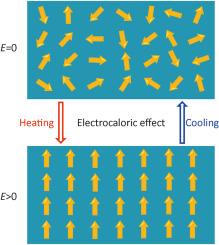Electrocaloric effects in ferroelectrics and multiferroics from first principles
IF 9.6
1区 材料科学
Q1 CHEMISTRY, PHYSICAL
引用次数: 0
Abstract
The electrocaloric (EC) effect characterizes the change in temperature or entropy of a material under the application of an external electric field. Ferroelectric and multiferroic materials have attracted considerable interest due to their potential for efficient solid-state refrigeration in a broad range of applications. In this review, we present recent applications of first-principles-based effective Hamiltonian, second-principles method, and spin Heisenberg model to study the EC effect in ferroelectrics, relaxor ferroelectrics, and multiferroic materials. Specifically, these methods are used to investigate the EC effect in perovskite ferroelectrics Pb(Zr0.4Ti0.6)O3, (Ba0.5Sr0.5)TiO3, PbTiO3, BaTiO3 and PbTiO3/SrTiO3 superlattices, relaxor ferroelectrics Ba(Zr, Ti)O3 and Pb(Mg, Nb)O3, as well as rare-earth-substituted BiFeO3, BiCoO3 and BiFeO3 multiferroics, and Nd-substituted BiFeO3 antiferroelectric solid solutions. Large electrocaloric responses are predicted in some of these compounds. In addition, we review the phenomenological models that can be used to analyze and understand these EC effect results.


从第一原理看铁电体和多铁电体的热效应
电热(EC)效应表征了材料在外加电场作用下的温度或熵的变化。铁电和多铁材料由于其在广泛的应用中具有高效固态制冷的潜力而引起了相当大的兴趣。本文综述了基于第一性原理的有效哈密顿量、第二原理方法和自旋海森堡模型在铁电体、弛豫铁电体和多铁材料中研究EC效应的最新应用。具体来说,这些方法用于研究钙钛矿铁电体Pb(Zr0.4Ti0.6)O3, (Ba0.5Sr0.5)TiO3, PbTiO3, BaTiO3和PbTiO3/SrTiO3超晶格,弛豫铁电体Ba(Zr, Ti)O3和Pb(Mg, Nb)O3,以及稀土取代的BiFeO3, BiCoO3和BiFeO3多铁质和nd取代的BiFeO3反铁电固溶体中的EC效应。在这些化合物中,预计会有较大的电热反应。此外,我们回顾了可用于分析和理解这些EC效应结果的现象学模型。
本文章由计算机程序翻译,如有差异,请以英文原文为准。
求助全文
约1分钟内获得全文
求助全文
来源期刊

Journal of Materiomics
Materials Science-Metals and Alloys
CiteScore
14.30
自引率
6.40%
发文量
331
审稿时长
37 days
期刊介绍:
The Journal of Materiomics is a peer-reviewed open-access journal that aims to serve as a forum for the continuous dissemination of research within the field of materials science. It particularly emphasizes systematic studies on the relationships between composition, processing, structure, property, and performance of advanced materials. The journal is supported by the Chinese Ceramic Society and is indexed in SCIE and Scopus. It is commonly referred to as J Materiomics.
 求助内容:
求助内容: 应助结果提醒方式:
应助结果提醒方式:


